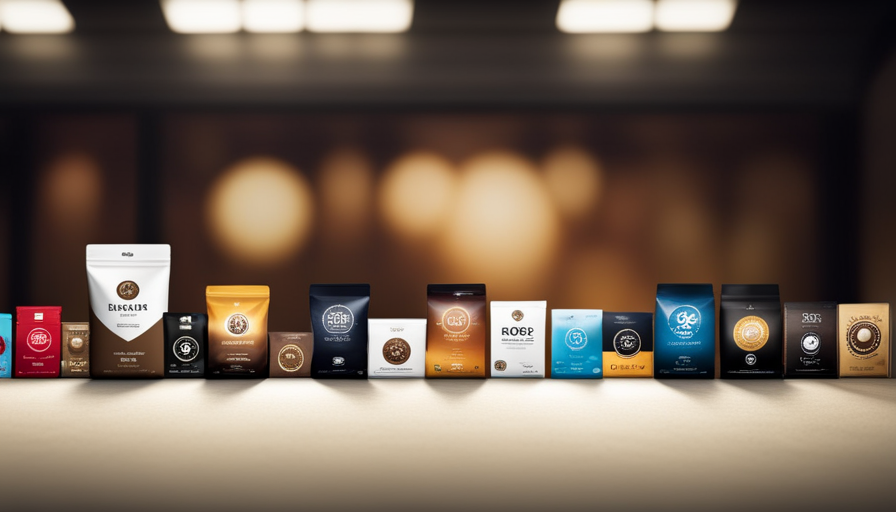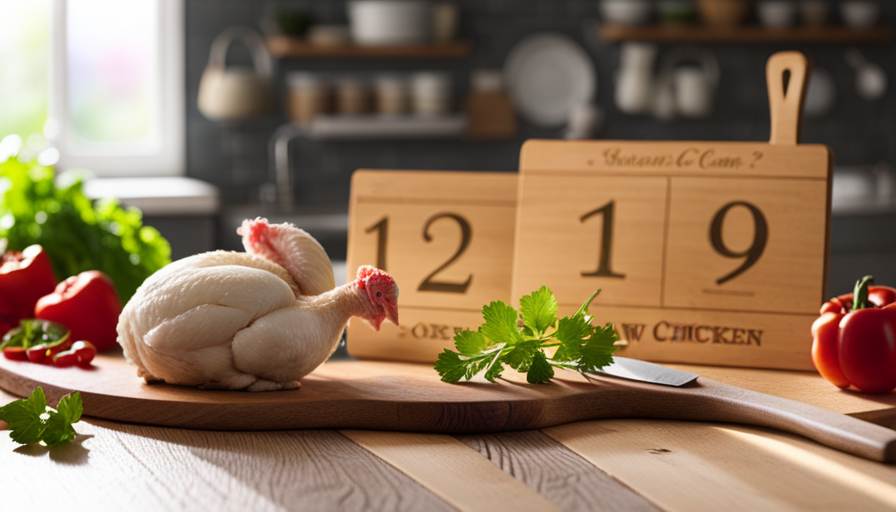By chance, understanding the proper storage of raw meat is crucial for maintaining food safety. As an individual who has a strong interest in cooking and keeping a tidy kitchen, I recognize the importance of using the correct storage methods.
In this article, I will guide you through the essential food terms and guidelines for storing raw meat, whether it be in the refrigerator or freezer. We will explore the differences between refrigerating and freezing, discuss cross-contamination prevention, and learn safe handling and defrosting techniques.
Additionally, I will provide insights into the proper storage of leftover cooked meat and shed light on the importance of regular cleaning and maintenance. By the end of this article, you will have a comprehensive understanding of how to store raw meat safely, ultimately reducing the risk of foodborne illnesses in your household.
So let’s dive in and ensure that your kitchen becomes a sanctuary of food safety!
Key Takeaways
- Raw meat should be stored in leak-proof, airtight containers or sealed freezer bags to prevent cross-contamination.
- Label packages with the date of freezing to track freshness.
- Maintain a consistent temperature in the freezer to prevent thawing and refreezing.
- Thaw meat in the refrigerator or using the defrost setting on the microwave, avoiding defrosting on the countertop to prevent bacterial growth.
Differentiate Between Refrigerating and Freezing
When it comes to storing raw meat, it’s important to understand the difference between refrigerating and freezing to ensure maximum freshness and safety.
Refrigerating raw meat involves keeping it at a temperature between 32°F and 40°F (0°C and 4°C). This slows down the growth of bacteria and helps maintain its freshness for a short period, usually a few days. However, refrigeration doesn’t completely stop bacterial growth, so it’s important to consume or freeze the meat within the recommended time frame.
Freezing raw meat, on the other hand, involves lowering its temperature to 0°F (-18°C) or below. This halts bacterial growth, effectively preserving the meat for a longer period. Freezing can extend the shelf life of raw meat for several months, maintaining its quality and reducing the risk of foodborne illnesses.
When it comes to best practices for raw meat storage, it’s important to follow a few guidelines. Always store raw meat in leak-proof, airtight containers or sealed freezer bags to prevent cross-contamination. Label the packages with the date of freezing to keep track of their freshness. Additionally, ensure that your freezer maintains a consistent temperature to prevent thawing and refreezing, which can negatively impact the meat’s quality.
Understanding the difference between refrigerating and freezing raw meat is crucial for maintaining its freshness and safety. Now, let’s delve into the specific guidelines for storing raw meat in the refrigerator.
Refrigerator Storage Guidelines
Refrigerator storage guidelines ensure that your groceries stay fresh and safe, giving you peace of mind. It’s important to understand the difference between refrigerating and freezing when it comes to storing raw meat.
Refrigeration keeps meat at a temperature between 32 to 40 degrees Fahrenheit, which slows down bacterial growth but doesn’t completely stop it. Freezing, on the other hand, keeps meat at 0 degrees Fahrenheit, which halts bacterial growth.
When storing raw meat in the refrigerator, it’s essential to follow safe handling and defrosting techniques. Store meat in airtight containers or sealed plastic bags to prevent cross-contamination. Place it on the bottom shelf to avoid any drips onto other foods.
Additionally, make sure to defrost meat properly by placing it in the refrigerator or using the defrost setting on your microwave. Never defrost meat on the countertop, as it can lead to the growth of harmful bacteria.
With these guidelines, you can ensure that your raw meat stays fresh and safe in the refrigerator.
Moving on to freezer storage guidelines…
Freezer Storage Guidelines
To ensure the longevity of your frozen items, it’s important to follow proper freezer storage guidelines. This includes maintaining a temperature below 0 degrees Fahrenheit. Did you know that a freezer set at 0 degrees Fahrenheit can keep food safe indefinitely?
When it comes to freezer organization, it’s essential to use the right containers for freezing. The best containers for freezing raw meat are airtight and leak-proof. This helps to prevent freezer burn and maintain the quality of the meat. Plastic freezer bags or containers made of heavy-duty plastic or glass are ideal options. Make sure to label the containers with the date and type of meat to keep track of what you have.
Additionally, you should store raw meat in the coldest part of the freezer, which is usually the back or bottom. This helps to ensure that the meat stays at a consistent temperature. By following these freezer storage guidelines and properly organizing your raw meat, you can prevent cross-contamination and keep your frozen items safe for consumption.
Speaking of cross-contamination prevention…
Cross-Contamination Prevention
Implementing proper food safety practices is crucial in preventing the transfer of harmful bacteria and ensuring the safety of your stored food items. When it comes to raw meat, cross-contamination prevention is especially important. Here are three key steps to follow for safe food handling and preventing contamination:
-
Separate: Always keep raw meat separate from other food items, both in the refrigerator and during preparation. This helps prevent the spread of bacteria from the meat to other foods.
-
Clean: Thoroughly clean all surfaces, utensils, and cutting boards that come into contact with raw meat. Use hot, soapy water to wash them and sanitize with a diluted bleach solution or a food-safe sanitizer.
-
Store: Store raw meat in leak-proof containers or sealed plastic bags to prevent any potential drips or leaks. Place the containers on a lower shelf in the refrigerator to prevent any accidental cross-contamination with other foods.
By following these safe food handling practices, you can greatly reduce the risk of cross-contamination and keep your stored food items safe.
Next, let’s explore safe handling and defrosting techniques for raw meat.
Safe Handling and Defrosting Techniques
Make sure you handle and defrost your meat safely to keep it delicious and bacteria-free. When it comes to defrosting techniques, it’s important to avoid leaving meat at room temperature for too long, as this can promote bacterial growth.
The safest way to defrost meat is to do it in the refrigerator. Simply place the meat in a leak-proof plastic bag and let it thaw slowly in the fridge. This method ensures that the meat stays at a safe temperature throughout the defrosting process.
If you need to defrost meat quickly, you can also use the cold water method. Fill a clean sink or basin with cold water and submerge the meat, making sure it is sealed in a leak-proof bag. Change the water every 30 minutes to keep it cold. Avoid using warm or hot water, as this can cause the outer layer of the meat to start cooking while the inside is still frozen.
When it comes to safe handling, always wash your hands thoroughly before and after handling raw meat. Use separate cutting boards and utensils for raw meat to prevent cross-contamination. After using them, wash them with hot, soapy water. Never place cooked food on a plate that previously held raw meat without washing it first.
With these defrosting techniques and safe handling practices, you can ensure that your meat stays safe to eat. In the next section, we’ll discuss the storage duration and shelf life of raw meat.
Storage Duration and Shelf Life
When it comes to storing different types of meat, it’s important to know the recommended storage time to ensure freshness and safety. Signs of spoilage and when to discard meat should also be taken into consideration. Additionally, understanding freezing and thawing cycles can help extend the shelf life of meat and prevent food waste.
Recommended Storage Time for Different Types of Meat
Store your raw meat in the appropriate container for the recommended storage time to ensure optimal freshness. Different types of meat have varying safe handling techniques and storage durations.
Beef and pork can be safely stored in the refrigerator for 3-5 days, while chicken and turkey should be used within 1-2 days. For longer storage, raw meat can be kept in the freezer. Ground meats can be stored for 3-4 months, while larger cuts like steaks and roasts can be kept for 6-12 months. It’s important to properly package the meat to prevent freezer burn.
Pay attention to the sell-by or use-by dates to ensure you consume the meat before it spoils. By following these guidelines, you can avoid consuming spoiled meat and keep your dishes safe and delicious.
Signs of Spoilage and When to Discard
To ensure your dishes are safe and delicious, it’s crucial for you to be able to recognize the signs of spoilage and know when to discard. When it comes to raw meat, there are several indicators that can help you determine if it’s gone bad. Look out for a strong, unpleasant odor, slimy texture, or a change in color. These are all signs that the meat may be spoiled and should be discarded.
Additionally, pay attention to the proper storage duration for different types of meat. Beef, pork, and lamb can be refrigerated for 3-5 days, while chicken and ground meat should be used within 1-2 days. Fish and seafood, on the other hand, should be consumed within 1-2 days as well.
With this knowledge, you can confidently ensure the freshness and quality of your meals.
Now, let’s move on to the next section about freezing and thawing cycles.
Freezing and Thawing Cycles
Get ready to discover the wonders of freezing and thawing your favorite ingredients! Freezing is a great way to extend the shelf life of raw meat and maintain its quality. Here are three freezing techniques to ensure your meat stays fresh:
-
Wrap it up: Before freezing, tightly wrap your meat in plastic wrap or place it in a freezer-safe container to prevent freezer burn and maintain moisture.
-
Label and date: Always label your frozen meat with the type and date of freezing. This will help you keep track of how long it’s been frozen and ensure you use it within a safe timeframe.
-
Thawing safety: When thawing your meat, it’s important to do it safely. The best way is to thaw it in the refrigerator overnight. If you’re in a hurry, you can use the defrost setting on your microwave, but make sure to cook it immediately afterwards.
Now that you know how to freeze and thaw your raw meat, let’s move on to learning about the proper storage for leftover cooked meat.
Proper Storage for Leftover Cooked Meat
When you’re finished with your delicious steak, make sure you wrap it up tightly in foil like a cozy blanket to keep it fresh in the fridge. Proper storage for leftover cooked meat is essential to maintain its quality and ensure safe consumption. To help you understand the best practices, here’s a table outlining safe handling techniques and proper reheating methods for cooked meat:
| Safe Handling Techniques | Proper Reheating Methods |
|---|---|
| Store cooked meat within 2 hours | Thaw in the refrigerator |
| Keep meat at or below 40°F | Reheat in the oven or stove |
| Separate cooked meat from raw | Use a meat thermometer to ensure proper internal temperature |
| Use clean utensils and surfaces | Avoid reheating multiple times |
Following these guidelines will minimize the risk of foodborne illnesses and help maintain the quality of your leftovers. It’s important to understand the potential dangers associated with improper storage and handling of cooked meat. By taking the necessary precautions, you can enjoy your leftovers without any concerns. Now, let’s delve into the next section about understanding foodborne illnesses.
Understanding Foodborne Illnesses
Understanding the causes and symptoms of foodborne illnesses is crucial for ensuring the safety of our meals. To prevent these illnesses, it’s important to practice safe handling and defrosting techniques. Here are four key points to keep in mind:
-
Proper Temperature: Bacteria grow rapidly at temperatures between 40°F and 140°F. It’s essential to keep perishable foods, especially raw meat, refrigerated at or below 40°F to slow down bacterial growth.
-
Cross-Contamination: Avoid cross-contamination by keeping raw meat separate from other foods. Use separate cutting boards and utensils for raw and cooked foods to prevent the spread of harmful bacteria.
-
Thorough Cooking: Cooking raw meat to the proper internal temperature kills bacteria and reduces the risk of foodborne illnesses. Use a food thermometer to ensure meat is cooked to the recommended temperature.
-
Defrosting Safely: When defrosting raw meat, it’s best to do so in the refrigerator or using the microwave. Avoid thawing meat at room temperature, as this allows bacteria to multiply.
Understanding foodborne illnesses and following safe handling and defrosting techniques are vital for maintaining food safety. By practicing these measures, we can reduce the risk of contamination and protect ourselves from harmful bacteria. Moving forward, it’s important to emphasize the importance of regular cleaning and maintenance to further ensure food safety.
Importance of Regular Cleaning and Maintenance
Regular cleaning and maintenance are crucial for preventing the spread of harmful bacteria in our kitchens. Did you know that a study found that 90% of kitchen sponges contain bacteria like E. coli and salmonella?
Keeping our kitchen surfaces, utensils, and appliances clean is essential to ensuring food safety. Regularly washing cutting boards, knives, and countertops with hot, soapy water can help remove any potential contaminants. Additionally, it’s important to sanitize these surfaces after each use to kill any remaining bacteria.
Regular maintenance of kitchen equipment, such as refrigerators and ovens, is also essential. Checking and cleaning refrigerator coils, removing any spoiled food, and regularly defrosting freezers can help maintain proper temperatures and prevent the growth of harmful bacteria.
By incorporating regular cleaning and maintenance practices into our routine, we can create a safer and healthier environment for preparing and storing food. To learn more about proper food handling and storage, resources and additional information can be found in reputable food safety organizations’ websites.
Resources and Additional Information
When it comes to ensuring food safety, there are several valuable resources and additional information available.
Government websites and guidelines provide comprehensive information on food safety regulations and best practices.
Food safety organizations and resources offer additional guidance and support, while online courses and certifications provide opportunities to enhance knowledge and skills in food safety.
These resources can be incredibly helpful in maintaining high standards of cleanliness and safety in the food industry.
Government Websites and Guidelines
Government websites and guidelines provide essential information on the proper storage of raw meat, ensuring your family’s safety and peace of mind. When it comes to storing raw meat, it’s important to follow government regulations and food safety guidelines to prevent the growth of harmful bacteria. Here are three sub-lists of important considerations:
-
Temperature: Raw meat should be stored at temperatures below 40°F to slow down bacterial growth.
-
Packaging: It’s crucial to store raw meat in leak-proof and airtight packaging to prevent cross-contamination and the spread of bacteria.
-
Placement: Raw meat should always be stored on the lowest shelf of the refrigerator, below ready-to-eat foods, to avoid any potential drips or spills.
By adhering to these guidelines, you can ensure that your raw meat stays fresh and safe to consume.
Moving forward, let’s explore food safety organizations and resources for more information on this topic.
Food Safety Organizations and Resources
As I mentioned earlier, government websites and guidelines are an essential resource for understanding food safety regulations. However, it’s also important to explore other organizations and resources that specialize in food safety. These organizations provide valuable information on best practices and offer guidance to individuals and businesses in the food industry. By following their recommendations, we can ensure that we are handling and storing raw meat in a safe and hygienic manner. To make the information more accessible and engaging, I have created a table below that highlights some key food safety organizations and resources. This table provides a quick overview of their services and areas of expertise. By familiarizing ourselves with these organizations and utilizing their resources, we can stay up-to-date with government regulations and implement best practices in our food handling and storage procedures. Now, let’s move on to the next section about online courses and certifications in food safety.
Online Courses and Certifications in Food Safety
To enhance your knowledge and expertise in handling and storing food safely, consider enrolling in online courses and earning certifications in food safety.
Online courses provide a convenient way to learn about food safety from the comfort of your own home. These courses cover a wide range of topics, including proper food handling and storage, prevention of foodborne illnesses, and regulations and guidelines set by food safety organizations.
Additionally, earning certifications in food safety can help you stand out in the job market and demonstrate your commitment to maintaining high standards of food safety. There are various online platforms and organizations that offer these courses and certifications, such as the National Restaurant Association’s ServSafe program and the Food Safety Preventive Controls Alliance.
Taking these courses and earning certifications can greatly enhance your understanding of food safety practices and ensure the safety and well-being of consumers.
Frequently Asked Questions
Can I store raw meat at room temperature for a short period of time?
Sure, I’d love to help! But let me be clear – storing raw meat at room temperature, even for a short period of time, is a big no-no. It can lead to bacterial growth and foodborne illnesses.
To keep your meat safe and fresh, follow these best practices for raw meat storage: always refrigerate or freeze it promptly, store it in airtight containers or sealed bags, and make sure to separate it from other foods to prevent cross-contamination.
Safety first, always!
How often should I clean my refrigerator to prevent cross-contamination?
To properly clean a refrigerator and prevent cross-contamination, it’s important to follow these steps.
First, remove all items from the fridge and discard any expired or spoiled food.
Next, wipe down all surfaces with a mixture of warm water and dish soap. Pay special attention to the shelves, drawers, and door seals.
Rinse with clean water and dry thoroughly.
Finally, organize food properly, using separate containers for raw meat to prevent contamination.
Regularly cleaning your refrigerator helps maintain a safe and healthy environment for storing food.
Is it safe to store raw meat on the top shelf of the refrigerator?
No, it isn’t safe to store raw meat on the top shelf of the refrigerator. Raw meat should be stored on the bottom shelf to prevent any potential cross-contamination with other foods. It’s important to keep raw meat separate from ready-to-eat foods to avoid the spread of harmful bacteria.
Additionally, it’s not recommended to marinate raw meat on the countertop before refrigerating it, as this can also increase the risk of bacterial growth.
Can I freeze cooked meat that has already been frozen once before?
Yes, you can freeze cooked meat that’s already been frozen once before. However, there are a few things to keep in mind. Freezing can affect the taste and texture of the meat, so it may not be as good as the first time. It’s also important to properly wrap and seal the meat to prevent freezer burn. When thawing and reheating, make sure to follow safe food handling practices to avoid any potential health risks.
Are there any specific guidelines for storing raw meat in a deep freezer?
When it comes to deep freezer storage for raw meat, there are some best practices to follow. First, make sure the meat is properly wrapped in airtight packaging to prevent freezer burn.
It’s also important to label the packages with the type and date of the meat.
Store the meat in the coldest part of the freezer to maintain its quality.
Lastly, avoid overcrowding the freezer to allow for proper air circulation.
Can I Use the Same Storage Method for Raw Meat as Other Raw Foods?
When it comes to storing raw food, images of proper handling and separate storage for raw meat come to mind. It is best to keep raw meat in its own designated container or section of the refrigerator to prevent cross-contamination with other raw foods.
Conclusion
In conclusion, properly storing raw meat is crucial to ensuring food safety and preventing foodborne illnesses. Just like a well-maintained fortress protects its inhabitants, refrigerating or freezing raw meat safeguards us from harmful bacteria.
By following storage guidelines, practicing cross-contamination prevention, and implementing safe handling techniques, we can enjoy delicious meals without risking our health.
Remember, a clean and well-maintained kitchen is the first line of defense against foodborne illnesses. So, let’s prioritize food safety and protect ourselves with proper storage and handling practices.
Stay safe and enjoy your meals!

















